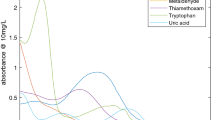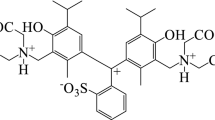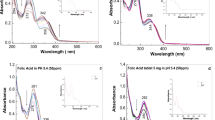Abstract
DIFFERENTIAL analysis of mixtures is an accepted technique in ultra-violet spectrophotometry1, and it is the purpose of this communication to describe the successful application of this technique to infra-red solution analysis, where a double-beam instrument is used. Double-beam infra-red spectrophotometers enable complex mixtures of isomeric or closely related substances to be analysed; but it is usually necessary to detect a major peak peculiar to a particular component of the mixture. This is not always possible, and minor peaks, or peaks where interference is present, have been used. In the latter case corrections are applied for the interfering substance, which is separately estimated. Interference can also affect the shoulders adjacent to an analytical peak, so, while the actual peak is unaffected, the resultant extinction coefficient is questionable, because the true base line (I 0 value) is in doubt.
This is a preview of subscription content, access via your institution
Access options
Subscribe to this journal
Receive 51 print issues and online access
$199.00 per year
only $3.90 per issue
Buy this article
- Purchase on Springer Link
- Instant access to full article PDF
Prices may be subject to local taxes which are calculated during checkout
Similar content being viewed by others
References
Beroza, M., Anal. Chem., 25, 112 (1953).
Author information
Authors and Affiliations
Rights and permissions
About this article
Cite this article
McDONALD, I. Quantitative Infra-Red Analysis of Mixtures. Nature 174, 703–704 (1954). https://doi.org/10.1038/174703b0
Issue Date:
DOI: https://doi.org/10.1038/174703b0
This article is cited by
-
Direct determination oftransunsaturation in triglycerides by infrared spectrophotometry
Journal of the American Oil Chemists' Society (1962)
Comments
By submitting a comment you agree to abide by our Terms and Community Guidelines. If you find something abusive or that does not comply with our terms or guidelines please flag it as inappropriate.



